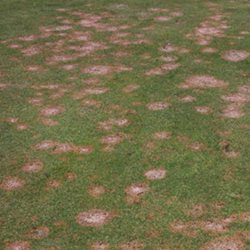Getting Rid of Snow Mold
The best way to combat snow mold in your yard is with preventative cultural practices. If snow mold has already taken hold in your yard, aeration and seeding can help you fight this fungus and have your lawn looking lush again. Read on for expert advice from the lawn care professionals at NaturaLawn of America.
Yes, snow mold is a real thing.
It may not be what you are picturing in your mind. Visions of green snow or odd growths appearing on your snowman would be far from the truth.
Snow mold is a lawn disease that shows up when an area of turf remains too wet, for too long, during colder months. Do you find yourself asking "What does it look like?" or "How can I prevent snow mold?" Well, we answer these questions and more below.
Why does snow mold happen?
The most favorable condition for snow mold is a cold, damp spot underneath snow or leaves for a period longer than 40 days. When the snow on your lawn begins to melt and as the daytime temperature reaches between 30°F and 45°F, snow mold can begin to spread rapidly. Conditions worsen in areas where moisture is abundant, such as protected, shady, depressed areas.
What does snow mold look like?
Snow mold will look like spots of color on your lawn which can begin as yellow-green and change to grey, white, or even pink. As the mold spreads, the outer rim of the circle will begin to turn grey to rusty pink and even run into other circles, forming a larger affected area.
How to prevent snow mold
- Rake leaves in the fall and mow the grass before it snows. Leaves and tall grass act as a layer of insulation, creating an ideal breeding ground for snow mold.
- Introduce disease-resistant grass types to your lawn when seeding.
- Use a slow-release organic-based fertilizer when it gets closer to winter. Fertilizers with lower levels of nitrogen are best because they won’t promote as much top growth.
- Have your lawn care technician take a soil sample or check your current sample results. A neutral to slightly acidic soil is ideal to minimize snow mold, so an adjustment to the pH level of the soil may be needed.
- Improve air circulation over the turf by pruning trees and ornamentals.
- Aerate the lawn in fall to reduce thatch and minimize the insulating layer of dead grass.
- Prevent excess water from sitting on the lawn through proper grading and drainage.
If your lawn already shows signs of snow mold, don't despair. Aeration is a great way to mitigate this problem so your lawn can bounce back quicker. Ask your lawn care technician to re-seed your lawn or repair bare spots when the time is appropriate. Be sure to follow the prevention tips above for next year as well.
More Lawn Care Expertise
If you have any further questions feel free to contact us; we’re always happy to help!








